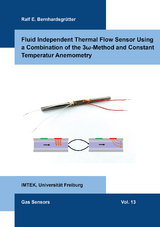Fluid Independent Thermal Flow Sensor Using a Combination of the 3ω-Method and Constant Temperatur Anemometry
Seiten
Thermal flow sensor principles have been known for over 100. The micro-machined flow sensors are widely used due to their simple measurement principle, their flexibility regarding application and their cost-efficiency. But still, the thermal sensors are highly fluid-dependent since the signal of thermal flow sensors does not only depend on the flow rate, but also on the thermal parameters of the fluid.This work presents a new approach to compensate for the fluid dependence of such a thermal sensor in the case of liquids, aiming for a fluid-independent thermal sensor. The investigated thermal flow sensor is based on the anemometric principle, which is dependent on the flow velocity, but also on the thermal parameters of the fluid. The proposed approach contains two thermal measurement principles, namely the 3 -method and the constant temperature anemometry to measure the flow velocity independently of the liquid. The idea is a two-step method. In the first step, the 3 -method is performed to characterize the fluid. In the second step, constant temperature anemometry is used to characterize the convection. Using the information of the fluid and the flow characterization, the flow velocity can be determined independently of the liquid.The method was tested both theoretically and experimentally for different liquids. The liquid characterization done by the 3 -method can be executed at no-flow or flow condition. Depending on the flow condition during the 3 -method, the accuracy of the flow velocity found in the experiment was 5% and 10% for the investigated liquids, respectively. Therefore, the proposed compensation method reduces the fluid dependence of a thermal flow sensor. Further work on this method may lead to a fluid-independent thermal flow sensor.
| Erscheinungsdatum | 08.12.2022 |
|---|---|
| Reihe/Serie | Gas Sensors ; 13 |
| Verlagsort | Düren |
| Sprache | englisch |
| Maße | 170 x 240 mm |
| Gewicht | 273 g |
| Themenwelt | Technik ► Elektrotechnik / Energietechnik |
| Schlagworte | 3 -method • 3ω-method • constant temperature anemometry • Flow sensing • fluid compensation • platinum thin film |
| ISBN-10 | 3-8440-8847-4 / 3844088474 |
| ISBN-13 | 978-3-8440-8847-2 / 9783844088472 |
| Zustand | Neuware |
| Haben Sie eine Frage zum Produkt? |
Mehr entdecken
aus dem Bereich
aus dem Bereich
Kolbenmaschinen - Strömungsmaschinen - Kraftwerke
Buch | Hardcover (2023)
Hanser (Verlag)
49,99 €




